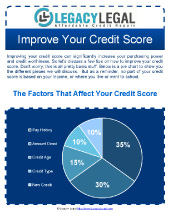Simple Steps to Improve Your Credit Scores
Tweet
Click the image to view the PDF document. Or, to download it, right click the image,
and select 'save target/link as . . .'
Improving your credit score can significantly increase your purchasing power and credit worthiness. So let's discuss a few tips on how to improve your credit score. Don't worry; this is all pretty basic stuff. Below is a pie chart to show you the different pieces we will discuss. But as a reminder, no part of your credit score is based on your income, or where you live or went to school.
The Factors That Affect Your Credit Score
1. Debt Repayment History
First, let's talk about your payment history. 35% of your credit score is based on your debt repayment history. Debts such as your credit cards, home loan and car loans report your payment history to the credit bureaus on how well or how poorly you pay on time (this fact alone means that some people are totally screwed).
If you were reported as paying any late payments, this could drop your credit scores dramatically and that could mess up your scores for a while – so don't do that. If you were not late, but your credit report says you were, you might want to consider credit repair (cuz we all know the credit bureaus never make mistakes, right? Yeah, uhuh). If you have no credit history, you're not totally screwed, so you can start by opening an account with the same institution where you do your banking. If you don't have a bank account, stop reading and go get one.
2. Balance-to-Credit-Limit Ratio
Next, - is your balance-to-credit-limit ratio. This is a little nerdy, so I will break it down for you. 30% of your credit score is based on your balance-to-credit-limit ratio, or in other words, how much of your credit limit is debt?. To figure our your ratio, divide the balance by your credit limit and it will give you the percentage of your balance-to-credit-limit ratio. For example, if you have a $1000 credit limit, and your balance is $500, that would mean you have a 50% ratio – yeah, that's too high!
To obtain the best credit score, your balance should be a minimum of 5% to a maximum of 25% balance-to-credit-limit ratio. Any higher than this means it is risky to the lender and he will give you the stink eye (that means your application is rejected). Any lower than this means the account may not be included in the calculation at all. This only applies to unsecured lines of credit, so your car loan and home loan are not included in your ratio. Sometimes if you miss a payment, your lender may drop or reduce your credit limit, which will drop your credit scores.
3. The Age of Your Credit Accounts
The age of your credit accounts counts for 15% of your credit score. The longer you manage your credit history the higher the credit score rating.To add some age to your credit history, talk with your parents or close friends about them adding you as an authorized user to their older (but perfectly paid) credit accounts with no balance. Their account will then show up on your credit history. This way, you can improve the age of your credit history and increase credit scores immediately. Don't do this with just any willing bozo, because if they screw up, it will mess up your credit!
Older accounts that are open with no balance are the best way to age and improve credit scores. The older a negative entry is on your credit, the better. But an old account with a negative history is better than a brand new account that is positive, or has too high of a balance-to-credit-limit ratio.
4. Types of Credit
10% of your credit score is based on the types of credit you have on your credit history. It is generally best to have a healthy mixture of types of credit to increase your credit score.
A mortgage and a car loan are types of installment loans. Credit cards and department stores are types of revolving loans. A signature loan is a type of personal or business loan. A loan for tuition and student housing is a type of student loan.
There are also types of credit entries that count against you. These may include high risk signature loans, such as payday loans, and loans that are generally repaid on a weekly basis. There are also types of credit that are always bad; such as third party collection agencies, judgments and liens.
5. New Credit
10% of your credit score is based on new credit. A new account can both help – and - hurt your credit score rating. Having a variety of types of new credit shows participation & responsibility.
These can hurt your scores
- A new collection account can hurt your scores
- A new account with a high balance-to-credit-limit ratio can hurt scores
- Many inquires can hurt your credit scores
- A new late payment can hurt your scores
These can improve your scores
- a new account with a low balance-to-credit-limit ratio can help
- a new type of loan that you have not had yet (new car, house, etc.)
- a paid off negative account
- an account that is removed from your credit




